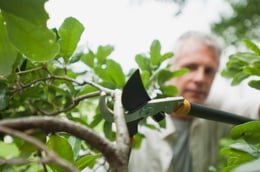 With the snow cover starting to disappear, you may be thinking about what projects you need to do in your yard this spring. One of those projects may be tree pruning. Now’s the best time to prune/trim your trees because they’re dormant.
With the snow cover starting to disappear, you may be thinking about what projects you need to do in your yard this spring. One of those projects may be tree pruning. Now’s the best time to prune/trim your trees because they’re dormant.
When trees are cut at this time of year, sap and resin flow is minimized. In essence, your tree won’t bleed as much.
Pruning trees in your yard or woods is essential for several reasons.
1. Safety.
By removing dead, damaged, or broken branches and limbs, you can prevent them from falling and hurting someone or causing property damage. First, prune the trees in those areas where you and your family spend a lot of time, like the swimming pool, shed, swing set/playground, deck or patio, and fire pit.
2. Health of the tree.
Pruning will help the tree's overall health by removing limbs or branches that are insect infested or diseased, or that rub and cause open wounds on the tree. Removing these branches will make more nutrients available for the rest of the tree, resulting in healthier leaves, flowers, and fruit.
3. Natural beauty.
If your property is heavily wooded, removing lower limbs or branches can allow more sunlight to come through, stimulating wildflower growth and improving the tree's overall surroundings. After a long cold winter, I look forward to all the sunlight I can get!
When pruning the trees on your property, remember these safety tips.
1. Wear proper clothing.
Proper clothing, such as long-sleeved shirts, long pants, and gloves can protect you from scratches, cuts, and insect bites.
2. Respect your chainsaw.
Improper use of your chainsaw can quickly cause significant injury. Remember these safety tips:
- Before using your chainsaw for the first time, have it inspected at your local hardware store. A dull chain is hard to work with and should be sharpened.
- Be sure you’re alert and have had plenty of rest. Working with a chainsaw is strenuous and tiring. Firing up the chainsaw after a late night may not be the best idea.
- Don’t use a ladder and a chainsaw together. A ladder on the unstable ground is very dangerous. If you need to work with a chainsaw well off the ground, consider renting a cherry picker or hiring a landscape professional.
- ALWAYS turn off the chainsaw when you’re not using it.
- Ask family members or friends for help if you have a big job. Then, if you’re injured, someone is there to help.
3. Protect your eyes and ears.
Wear safety glasses at all times. Even the most straightforward cut can cause injury. And if you’re working with a chainsaw or other loud power tools, wear ear protection. I’ve started using earplugs when I cut the lawn or weed whack. Not only does it protect my ears, it makes the job more pleasant.
4. Inspect the tree you’re working on.
Check for nests or hives. You certainly don’t want to be attacked by angry bees or a rabid squirrel.
5. Know which direction a tree will fall.
If you’re going to cut down an entire tree, research what type of cut is needed and where it will fall. If you’ve never done it before, consider hiring a landscape professional. The last thing you want is for the tree to fall on your house or car, and even worse, on you or someone you love.
6. Avoid alcohol consumption.
When you work outdoors, it’s essential to stay hydrated. Make sure you drink plenty of water. Mixing alcohol and power tools is NOT a safe combination.
Additional pruning tips
1. Start the pruning cycle when the trees are young.
When a tree is three to four years old, you can start pruning it, and you won’t have to use a ladder, which improves your overall safety. The project will be much more cumbersome if you start pruning when the tree has grown for ten years or more.
2. Prune when the tree is dormant.
Each time you cut a branch, a wound is created on the tree. When the tree comes out of dormancy in spring it will immediately begin scabbing over all the cuts. This is well before insect infestation can occur. However, if a branch is damaged or simply in your way, you can remove it at any time of the year. The exceptions would be August and September. This is because any time you prune a tree, it has a mechanism to create new growth to compensate for the loss. New growth that would occur in September and October likely won’t be able to survive the winter months.
3. Remember, it’s about quality, not quantity.
An important aspect of pruning is the quality of the cuts, not the number of branches removed from the trees. The end result is a healthy canopy. Before you start, have a goal in mind.
4. Contact a professional tree trimming service.
If the job is too big or complex, or you don’t know where to start, contact a local service. Ask your friends, co-workers, or family members for referrals. Or check with the Better Business Bureau to see how a company performs in your area.
Do you have any suggestions or information you’d like to share? I’d love to hear from you. Please share them in the box below.





